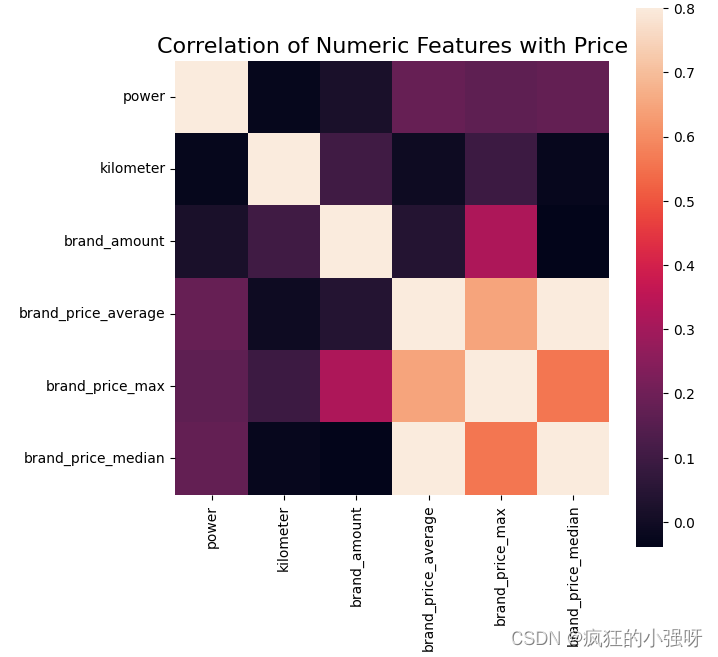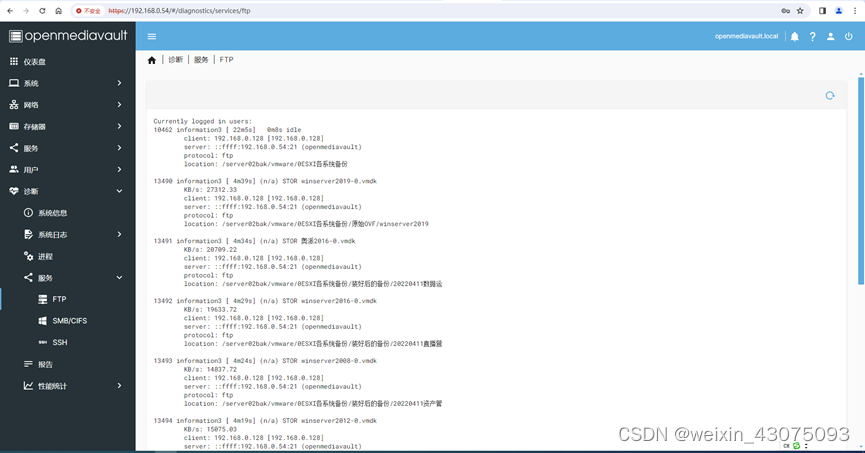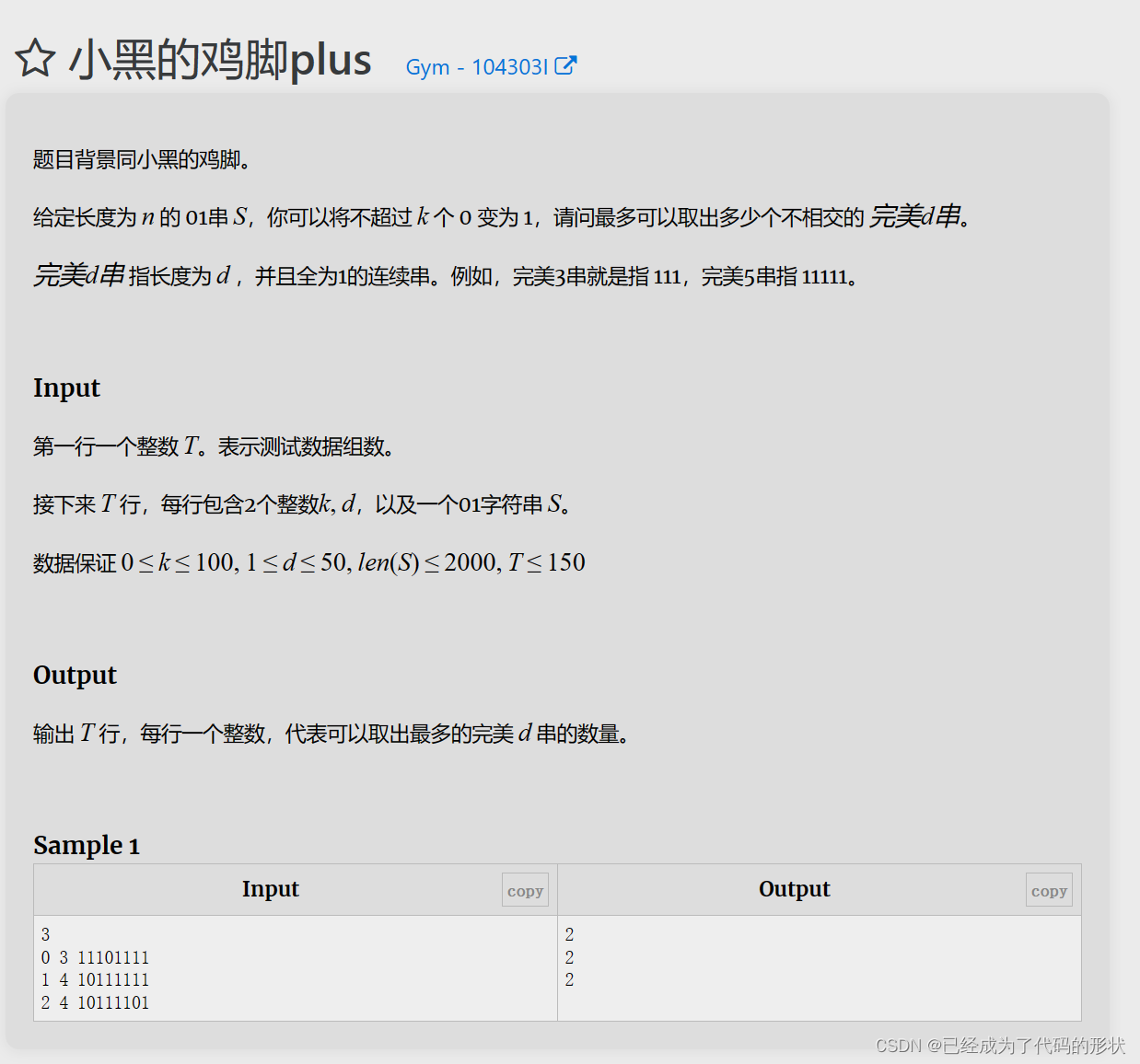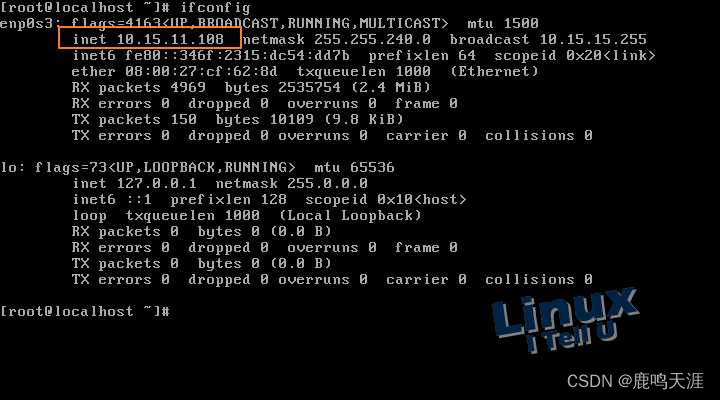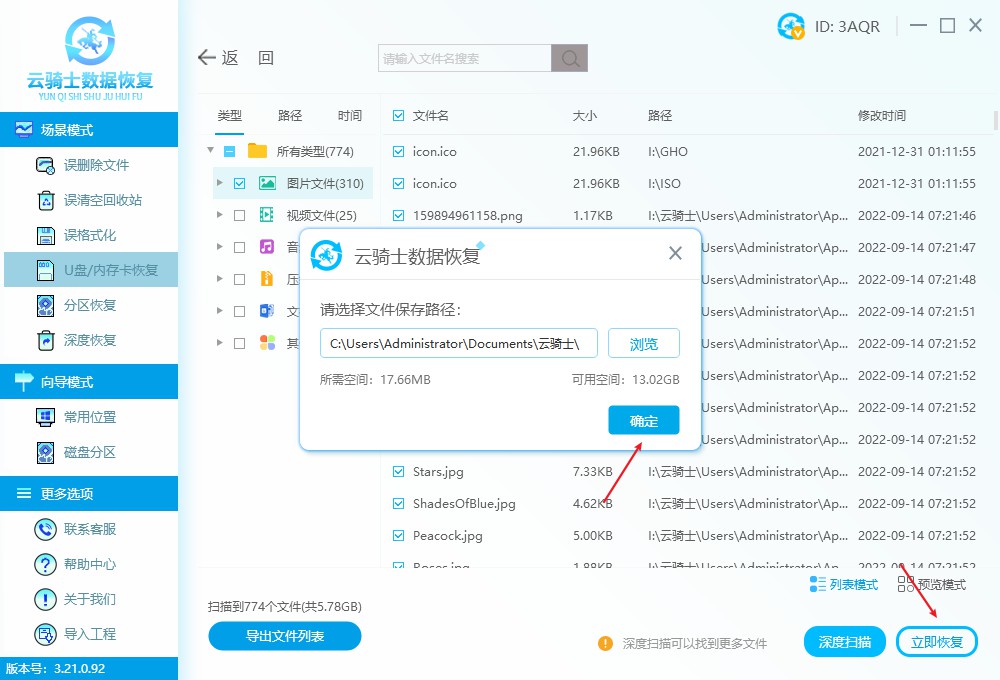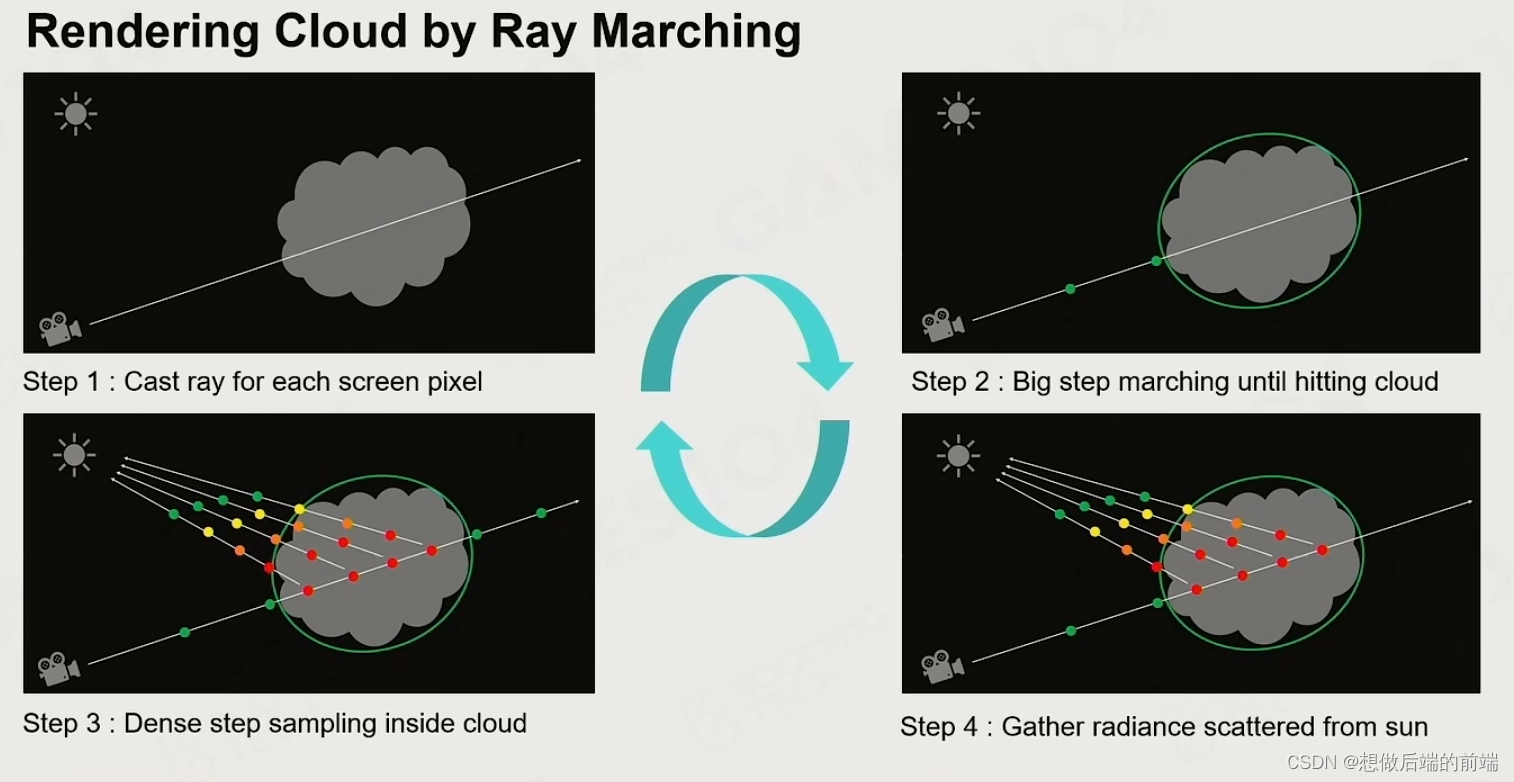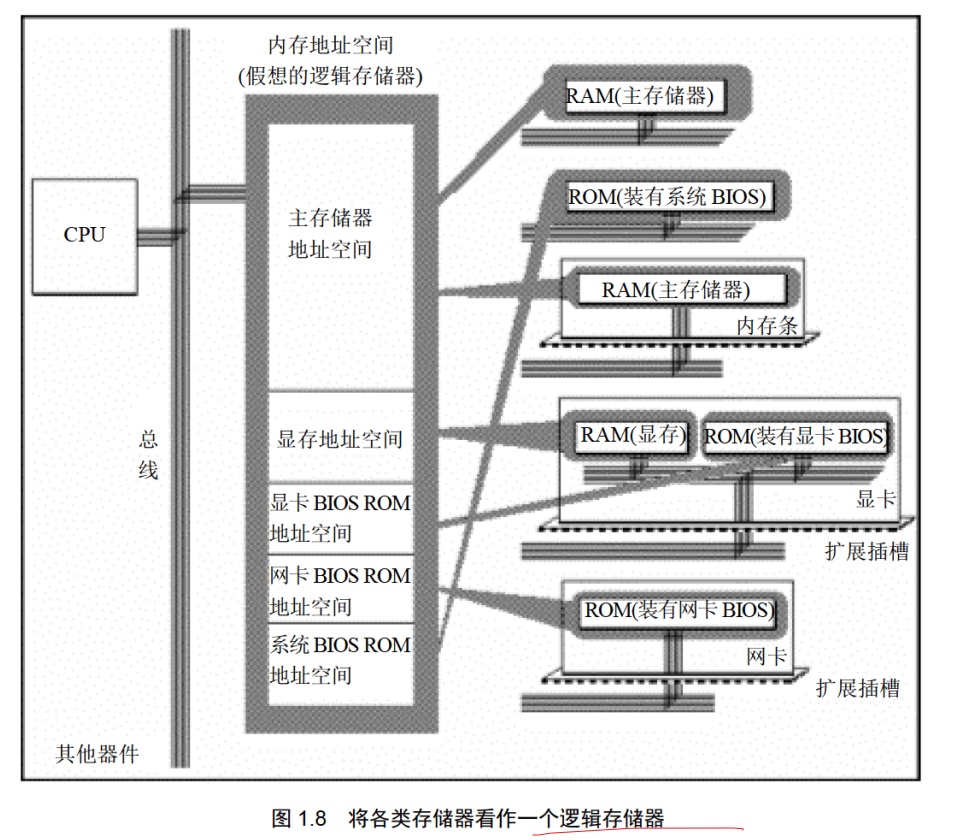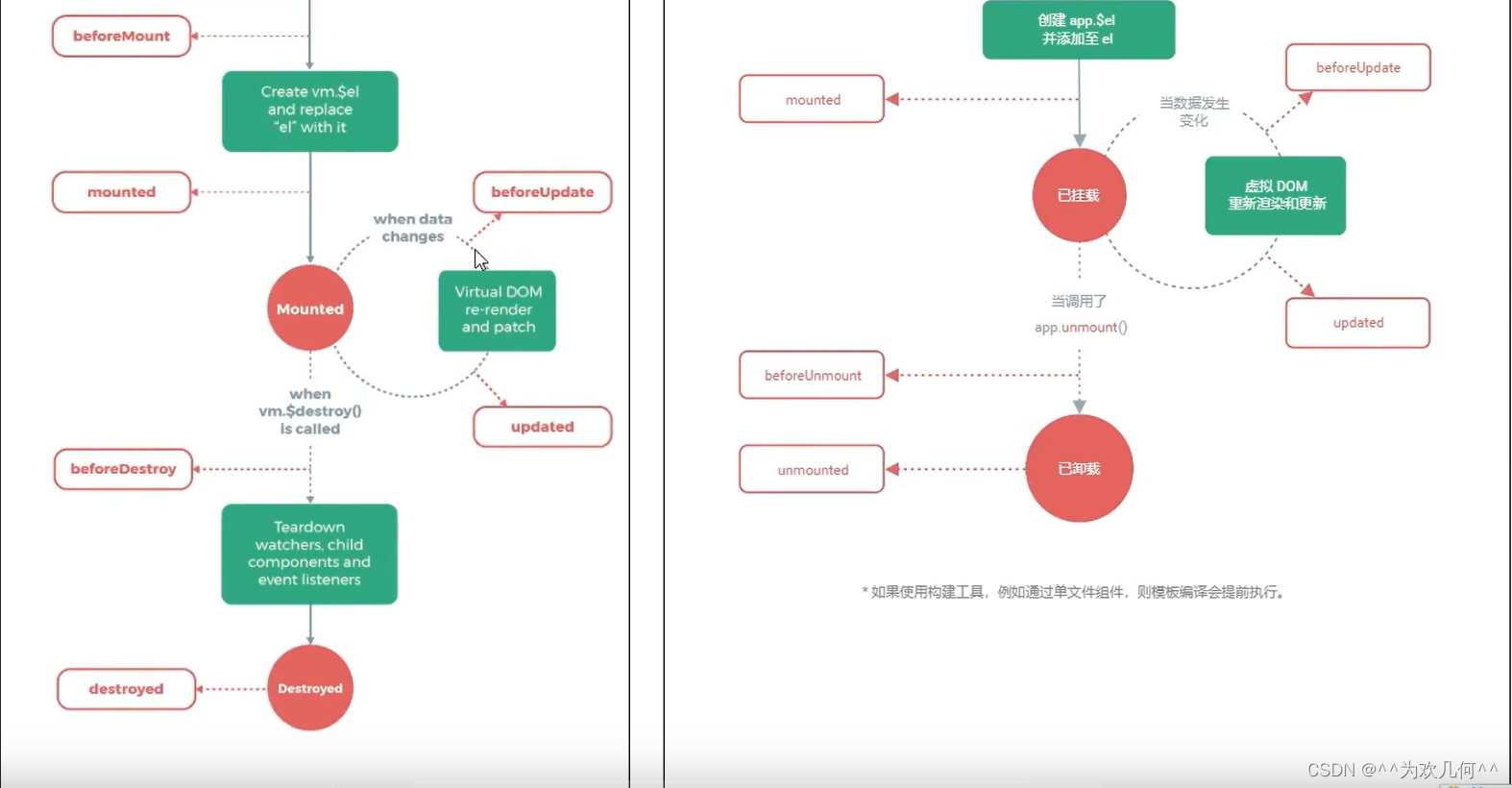Applied Spatial Statistics(一)统计推断
1.统计推断:Bootstrap 置信区间
本笔记本演示了如何使用引导方法构建统计数据的置信区间。 我们还将检查 CI 的覆盖概率。
- 构建 Bootstrap 置信区间
- 检查覆盖概率
- Bootstrap CI 相关系数
import numpy as np
import matplotlib.pyplot as plt
#Generate some random data
data = np.random.randn(100)*10 + 20
data
array([20.14846988, 13.40823552, 13.32946651, 19.12680721, 17.52762493,
45.23921971, 34.37879933, 18.87102583, 15.96800357, 25.24450873,
20.40852062, 22.59343075, 34.79216096, 16.89194103, 28.92760549,
18.84044456, 18.28049028, 20.10881674, 7.68688806, 10.37430632,
20.3172587 , 26.42390427, 39.13238623, 7.40129486, 4.38548135,
23.36831945, 26.89693477, 15.4169132 , 36.71645312, 7.00419646,
15.15546063, 13.59549372, 18.88764964, 30.84743651, 31.79246417,
1.91489133, 19.86336078, 21.92654346, 20.24120974, 19.78252461,
29.67569607, 22.84760632, 5.64987682, 8.71363322, 21.88605373,
23.48926653, 23.0107298 , 39.27012335, 13.98657903, 33.82055816,
20.11463245, 21.64808896, -0.70135753, 31.30912412, -1.16449383,
24.14380325, 35.47126313, 17.98800236, 18.58904375, 5.67235521,
21.28026186, 19.49719148, 41.08458071, 10.09613031, 31.31805292,
29.79117483, 13.69039686, 16.06187024, 35.57088589, 16.34373587,
17.45492499, 9.27927219, 18.36888727, 15.62266002, 17.47501537,
16.19066077, 22.28515871, 33.46323477, 10.23985703, 25.26497935,
5.08193247, 36.18867675, 12.35343392, 24.85332929, 6.87104071,
15.16828773, 28.68638639, 38.51222579, 0.90316588, 17.36319043,
9.1263876 , 10.78820054, 13.35119181, 39.2378541 , 17.60207791,
-1.29705377, 22.3886622 , 10.98409074, 20.81760636, 5.51315604])
plt.hist(data,bins=8)
(array([ 6., 13., 16., 30., 13., 9., 11., 2.]),
array([-1.29705377, 4.51998042, 10.3370146 , 16.15404879, 21.97108297,
27.78811715, 33.60515134, 39.42218552, 45.23921971]),
<BarContainer object of 8 artists>)
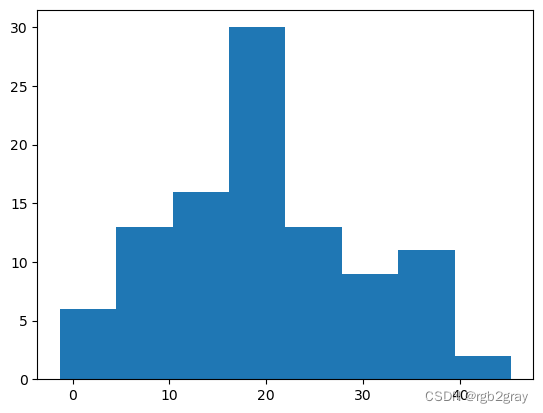
print("Population mean is:", np.mean(data))
print("Population variance is:", np.var(data))
Population mean is: 19.73510302232665
Population variance is: 105.44761217481347
#One sample with 30 numbers, this is what we have in hand.
sample_30 = np.random.choice(data, 30, replace=True)
sample_30
array([30.84743651, 39.13238623, 34.37879933, 13.32946651, 13.69039686,
9.1263876 , 6.87104071, 31.79246417, 10.98409074, 18.58904375,
18.87102583, 10.23985703, 13.59549372, 25.24450873, 26.42390427,
5.08193247, 31.79246417, 28.92760549, 15.4169132 , 8.71363322,
7.00419646, 25.26497935, 5.51315604, 22.28515871, 15.15546063,
30.84743651, 24.14380325, 13.98657903, 25.24450873, 0.90316588])
1.构建Bootstrap CI
#Define a bootstrap function:
def bootstrap(sample):
bootstrap_mean_list = []
for i in range(10000):
#generate a re-sample with the original sample size, with replacement
subsample = np.random.choice(sample, len(sample), replace=True)
#compute sub-sample mean
subsample_mean = np.mean(subsample)
bootstrap_mean_list.append(subsample_mean)
#Calculatet the mean and std of the bootstrap sampling distribution
bootstrap_mean = np.mean(bootstrap_mean_list)
boostrap_std = np.std(bootstrap_mean_list)
# mean +- 2*std for an approximate 95% CI.
CI = [(bootstrap_mean - 2*boostrap_std), (bootstrap_mean + 2*boostrap_std)]
return CI,bootstrap_mean_list
#Do the same thing for the percentile-based method:
def bootstrap_perc(sample):
bootstrap_mean_list = []
for i in range(1000):
#generate a re-sample with the original sample size, with replacement
subsample = np.random.choice(sample, len(sample), replace=True)
#compute sample mean
subsample_mean = np.mean(subsample)
bootstrap_mean_list.append(subsample_mean)
#Get the lower and upper bound for the middle 95%:
percentile_CI = [np.percentile(bootstrap_mean_list, 2.5),
np.percentile(bootstrap_mean_list, 97.5)]
return percentile_CI,bootstrap_mean_list
#Define a anlytical based function:
def anlytical(sample):
sample_mean = np.mean(sample)
err_of_margin = 2*np.std(sample)/np.sqrt(len(sample))
# mean +- 2*std for an approximate 95% CI.
CI_lower = sample_mean - err_of_margin
CI_upper = sample_mean + err_of_margin
CI = [CI_lower, CI_upper]
return CI
比较引导 CI 与分析 CI:
bootstrap_CI, bootstrap_mean_list = bootstrap(sample_30)
bootstrap_CI_perc, bootstrap_mean_list_perc = bootstrap_perc(sample_30)
analytical_CI = anlytical(sample_30)
print("95% analytical CI: ", analytical_CI)
print("95% bootstrap CI: ", bootstrap_CI)
print("95% percentile-based bootstrap CI: ", bootstrap_CI_perc)
95% analytical CI: [15.105707709695746, 22.45411196607375]
95% bootstrap CI: [15.166149117216644, 22.429589185859715]
95% percentile-based bootstrap CI: [15.128839804780965, 22.302901561304623]
- 测试 95% CI 的覆盖率
- 引导程序
- 基于百分位数的 Bootstrap
- 分析
%%time
#generate samples for multiple times
counter = 0
counter_perc = 0
true_mean = np.mean(data)
for i in range(1000):
#generate a sample with 30 numbers
sample = np.random.choice(data, 30, replace=True)
#For each sample, we compute the two CIs:
ci,_ = bootstrap(sample)
perc_ci,_ = bootstrap_perc(sample)
analytical_ci = anlytical(sample)
#Check the coverage
if ci[0] <= true_mean <= ci[1]:
counter = counter + 1
if perc_ci[0] <= true_mean <= perc_ci[1]:
counter_perc = counter_perc + 1
CPU times: total: 28.3 s
Wall time: 2min 6s
print("Number of times 95% bootstrap CI covered the population mean:",
counter,"out of 1000")
Number of times 95% bootstrap CI covered the population mean: 944 out of 1000
print("Number of times 95% percentile-based bootstrap CI covered the population mean:",
counter,"out of 1000")
Number of times 95% percentile-based bootstrap CI covered the population mean: 944 out of 1000
print("Number of times 95% analytical CI covered the population mean:",
counter,"out of 1000")
Number of times 95% analytical CI covered the population mean: 944 out of 1000
- 相关系数的 Bootstrap 置信区间
import pandas as pd
url = 'https://raw.githubusercontent.com/mwaskom/seaborn-data/master/mpg.csv'
df = pd.read_csv(url)
df = df.dropna()
from scipy.stats import *
plt.scatter(df.horsepower, df.acceleration)
plt.xlabel("Horsepower")
plt.ylabel("Acceleration")
d:\work\miniconda3\lib\site-packages\scipy\__init__.py:146: UserWarning: A NumPy version >=1.16.5 and <1.23.0 is required for this version of SciPy (detected version 1.23.3
warnings.warn(f"A NumPy version >={np_minversion} and <{np_maxversion}"
Text(0, 0.5, 'Acceleration')
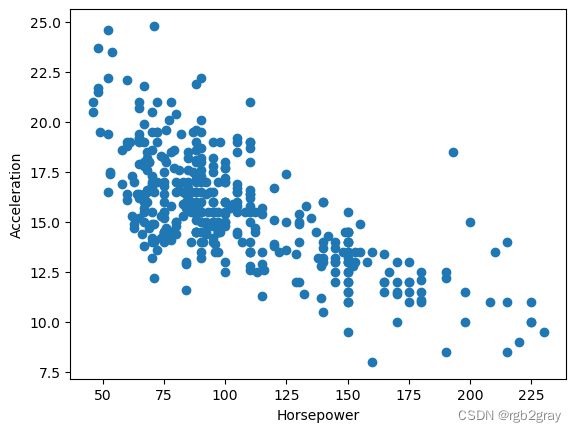
print("Pearson:",pearsonr(df.horsepower, df.acceleration))
Pearson: (-0.6891955103342369, 1.5818862297814436e-56)
sample_car = df.sample(frac=0.3,replace=True)
sample_car
| mpg | cylinders | displacement | horsepower | weight | acceleration | model_year | origin | name | |
|---|---|---|---|---|---|---|---|---|---|
| 238 | 33.5 | 4 | 98.0 | 83.0 | 2075 | 15.9 | 77 | usa | dodge colt m/m |
| 194 | 22.5 | 6 | 232.0 | 90.0 | 3085 | 17.6 | 76 | usa | amc hornet |
| 380 | 36.0 | 4 | 120.0 | 88.0 | 2160 | 14.5 | 82 | japan | nissan stanza xe |
| 142 | 26.0 | 4 | 79.0 | 67.0 | 1963 | 15.5 | 74 | europe | volkswagen dasher |
| 312 | 37.2 | 4 | 86.0 | 65.0 | 2019 | 16.4 | 80 | japan | datsun 310 |
| ... | ... | ... | ... | ... | ... | ... | ... | ... | ... |
| 271 | 23.2 | 4 | 156.0 | 105.0 | 2745 | 16.7 | 78 | usa | plymouth sapporo |
| 136 | 16.0 | 8 | 302.0 | 140.0 | 4141 | 14.0 | 74 | usa | ford gran torino |
| 332 | 29.8 | 4 | 89.0 | 62.0 | 1845 | 15.3 | 80 | europe | vokswagen rabbit |
| 272 | 23.8 | 4 | 151.0 | 85.0 | 2855 | 17.6 | 78 | usa | oldsmobile starfire sx |
| 85 | 13.0 | 8 | 350.0 | 175.0 | 4100 | 13.0 | 73 | usa | buick century 350 |
118 rows × 9 columns
print("Pearson:",pearsonr(sample_car.horsepower, sample_car.acceleration))
Pearson: (-0.7670736293678354, 4.176876123725007e-24)
#Define a bootstrap function:
np.random.seed(222)
def bootstrap_pearson(sample_car):
bootstrap_cor_list = []
for i in range(10000):
#generate a re-sample with the original sample size, with replacement
subsample = sample_car.sample(len(sample), replace=True)
#compute correlation
sample_cor = pearsonr(subsample.horsepower, subsample.acceleration)[0]
bootstrap_cor_list.append(sample_cor)
#Get the lower and upper bound for the middle 95%:
percentile_CI = [np.percentile(bootstrap_cor_list, 2.5),
np.percentile(bootstrap_cor_list, 97.5)]
return percentile_CI
bootstrap_pearson(sample_car)
[-0.897486157722385, -0.49473536389623324]
print("95% confidence interval of the Pearson correlation coefficient is:",
"[-0.855 to -0.606]")
95% confidence interval of the Pearson correlation coefficient is: [-0.855 to -0.606]
我们有 95% 的信心认为人群中 HP 和 ACC 的真实相关性在 -0.855 到 -0.606 之间。
在这种情况下,CI 不覆盖 0,这意味着总体相关系数不为零。 因此,我们从样本中观察到的负趋势不仅仅是因为抽样变化,而是因为总体中真正的相关性是负的。
_cor_list, 97.5)]
return percentile_CI
```python
bootstrap_pearson(sample_car)
[-0.897486157722385, -0.49473536389623324]
print("95% confidence interval of the Pearson correlation coefficient is:",
"[-0.855 to -0.606]")
95% confidence interval of the Pearson correlation coefficient is: [-0.855 to -0.606]
我们有 95% 的信心认为人群中 HP 和 ACC 的真实相关性在 -0.855 到 -0.606 之间。
在这种情况下,CI 不覆盖 0,这意味着总体相关系数不为零。 因此,我们从样本中观察到的负趋势不仅仅是因为抽样变化,而是因为总体中真正的相关性是负的。
2.统计推断置信区间
本笔记本演示了估计的置信区间 (CI) 的概念。 我们将检查 CI 的覆盖概率。
考虑这样一个场景:FSU 有 20,000 名学生,他们的智商水平服从正态分布,平均值为 110,标准差为 10。 让我们从学生群体中抽取样本,并检查样本与总体之间的关系。
import numpy as np
import matplotlib.pyplot as plt
生成人口数据
N = 20000 #20,000 students
#Generate from a normal distribution
data = np.random.randn(N)*10 + 110
plt.hist(data)
(array([ 48., 288., 1185., 3287., 5481., 5239., 3162., 1050., 230.,
30.]),
array([ 73.30451127, 80.71913869, 88.13376612, 95.54839355,
102.96302097, 110.3776484 , 117.79227582, 125.20690325,
132.62153068, 140.0361581 , 147.45078553]),
<BarContainer object of 10 artists>)
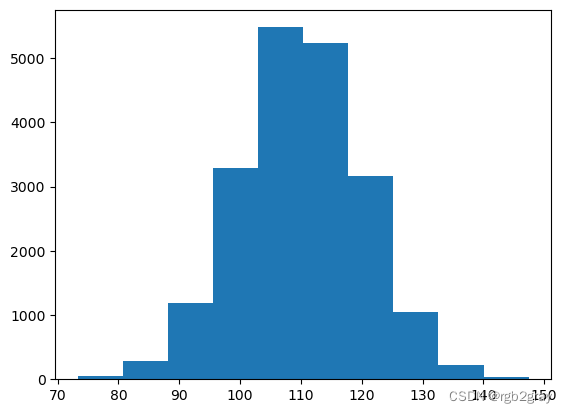
print("Population mean is:", np.mean(data))
print("Population variance is:", np.var(data))
Population mean is: 110.01962672036136
Population variance is: 102.25452537436367
现在让我们抽取样本。 让我们从 10 名学生的样本开始
#One sample with 10 numbers
sample_10 = np.random.choice(data, 10)
sample_10
array([109.62388683, 91.97729472, 100.46429321, 111.00988364,
108.31788058, 113.66683355, 109.74268367, 113.06416223,
105.39076392, 122.01725268])
print("The sample mean is: ", np.mean(sample_10))
The sample mean is: 108.52749350347217
如果我们重复采样过程(例如 1,000 次)怎么样?
从 t 分布获取临界 t 值。 自由度:10-1(样本大小 - 1)。 置信区间宽度:95%。
from scipy import stats
t = stats.t.ppf(1-0.05/2, 9)
print(t)
d:\work\miniconda3\lib\site-packages\scipy\__init__.py:146: UserWarning: A NumPy version >=1.16.5 and <1.23.0 is required for this version of SciPy (detected version 1.23.3
warnings.warn(f"A NumPy version >={np_minversion} and <{np_maxversion}"
2.2621571627409915
coverage_list = []
for i in range(1000):
#generate a sample with 10 numbers
sample = np.random.choice(data, 10)
#compute sample mean
sample_mean = np.mean(sample)
err_of_margin = t*np.std(sample)/np.sqrt(10)
CI_lower = sample_mean - err_of_margin
CI_upper = sample_mean + err_of_margin
true_mean = np.mean(data)
is_covered = (true_mean>=CI_lower) and (true_mean<=CI_upper)
print(i," 95% confidence interval ", [CI_lower, CI_upper], "Cover the true mean?", is_covered)
coverage_list.append(is_covered)
0 95% confidence interval [102.7151079840605, 118.2405606324954] Cover the true mean? True
1 95% confidence interval [104.23885267719237, 118.10221181506196] Cover the true mean? True
2 95% confidence interval [103.72346627181192, 115.9391835906615] Cover the true mean? True
3 95% confidence interval [104.62550349440005, 115.14252771113254] Cover the true mean? True
4 95% confidence interval [102.12727319514039, 112.16268597210077] Cover the true mean? True
5 95% confidence interval [101.08352856103731, 118.69180761678739] Cover the true mean? True
6 95% confidence interval [103.18857595332162, 113.00591633235916] Cover the true mean? True
7 95% confidence interval [103.55533372607188, 110.30496134366432] Cover the true mean? True
8 95% confidence interval [90.18976464492026, 103.9824575401898] Cover the true mean? False
9 95% confidence interval [102.14358563332436, 115.72116848794366] Cover the true mean? True
10 95% confidence interval [100.80227845656053, 111.93303378484153] Cover the true mean? True
11 95% confidence interval [103.89446446670988, 114.34313482587856] Cover the true mean? True
12 95% confidence interval [100.7487394903015, 111.36109764079389] Cover the true mean? True
3.统计推断点估计
本笔记本演示了统计量抽样分布的概念。 这也表明
- 样本均值是无偏的
- 样本方差是无偏的
- 均值和方差抽样变异的解析解
考虑这样一个场景:FSU 有 20,000 名学生,他们的智商水平服从正态分布,平均值为 110,标准差为 10。 让我们从学生群体中抽取样本,并检查样本与总体之间的关系。
样本平均值
import numpy as np
import matplotlib.pyplot as plt
生成人口数据
N = 20000 #20,000 students
#Generate from a normal distribution
data = np.random.randn(N)*10 + 110
plt.hist(data)
(array([ 8., 142., 843., 3136., 5751., 5935., 3176., 867., 127.,
15.]),
array([ 69.32483145, 77.45863551, 85.59243958, 93.72624364,
101.8600477 , 109.99385177, 118.12765583, 126.26145989,
134.39526396, 142.52906802, 150.66287208]),
<BarContainer object of 10 artists>)
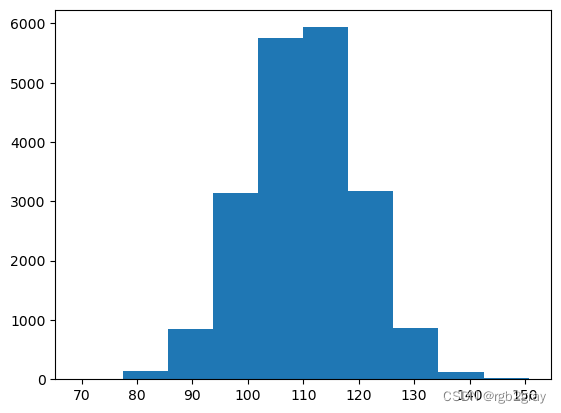
print("Population mean is:", np.mean(data))
print("Population variance is:", np.var(data))
Population mean is: 110.07413289511938
Population variance is: 98.89323295421896
现在让我们抽取样本。 让我们从 10 名学生的样本开始
#One sample with 10 numbers
sample_10 = np.random.choice(data, 10)
sample_10
array([111.66777512, 112.16222242, 118.08689454, 110.24523641,
125.48603522, 88.41367076, 125.67988677, 113.88800138,
108.6807358 , 121.01857026])
print("The sample mean is: ", np.mean(sample_10))
The sample mean is: 113.53290286905217
如果我们重复采样过程(例如 1,000 次)怎么样?
#Create an empty list to hold the numbers from each sample
sample_10_mean_list = []
for i in range(1000):
#generate a sample with 10 numbers
sample = np.random.choice(data, 10)
#compute sample mean
sample_mean = np.mean(sample)
print(i," sample mean: ", sample_mean)
#append them to the list
sample_10_mean_list.append(sample_mean)
0 sample mean: 108.17391918529407
1 sample mean: 111.67818693824806
2 sample mean: 111.67822497907324
3 sample mean: 107.24418829414785
4 sample mean: 113.17329723752623
5 sample mean: 112.9070413608591
6 sample mean: 108.04910734829619
7 sample mean: 112.5903576727253
8 sample mean: 113.62852862972878
9 sample mean: 113.27149334572691
10 sample mean: 107.76969738534706
11 sample mean: 109.1620666792978
12 sample mean: 103.71358812699627
13 sample mean: 107.697395964914
14 sample mean: 110.8082408750503
15 sample mean: 110.92158184257207
16 sample mean: 108.58419010871549
17 sample mean: 109.65230764397218
18 sample mean: 109.86678913378717
19 sample mean: 105.08768958694495
20 sample mean: 106.88640190007649
21 sample mean: 112.56008138539062
22 sample mean: 110.83395797118828
23 sample mean: 110.73008027594503
24 sample mean: 109.3294505313664
25 sample mean: 110.04042595076564
26 sample mean: 109.67050530705797
27 sample mean: 108.32738807341839
28 sample mean: 108.49314412381798
29 sample mean: 107.1858761872827
30 sample mean: 112.46187853160286
31 sample mean: 113.12349039970186
32 sample mean: 110.14207252003163
33 sample mean: 110.75599034550528
34 sample mean: 106.8240410457283
35 sample mean: 111.8765477301838
36 sample mean: 113.82299698648565
37 sample mean: 109.31286148365352
38 sample mean: 111.97700620796886
39 sample mean: 109.9008197839028
40 sample mean: 107.69013776731724
41 sample mean: 114.28574317155494
42 sample mean: 109.50146395888653
43 sample mean: 107.40447023607123
44 sample mean: 116.24621309981323
45 sample mean: 112.67872689503027
46 sample mean: 106.53331942661855
47 sample mean: 110.35618578397953
48 sample mean: 107.67531638860439
49 sample mean: 111.03510449989963
50 sample mean: 109.03305491756535
51 sample mean: 111.12749226215763
52 sample mean: 107.44884335343575
53 sample mean: 111.4216569660086
54 sample mean: 112.14976633180977
55 sample mean: 108.046169949935
56 sample mean: 107.78856332959371
57 sample mean: 115.0407995071375
58 sample mean: 107.82026621773139
59 sample mean: 106.80442741389179
60 sample mean: 109.07177961379848
61 sample mean: 110.57205199833035
62 sample mean: 107.35628147704801
63 sample mean: 107.84236667449561
64 sample mean: 111.90515735465651
65 sample mean: 114.4823745877502
66 sample mean: 102.21096088759352
67 sample mean: 112.18457688111475
68 sample mean: 107.4440654002789
69 sample mean: 108.47620386204194
70 sample mean: 115.00823605453897
71 sample mean: 106.75913949864893
72 sample mean: 111.13852427880879
73 sample mean: 108.95844954274037
74 sample mean: 113.59768517919773
75 sample mean: 111.31910512168243
76 sample mean: 106.38067170844681
77 sample mean: 109.49375945640797
78 sample mean: 115.093047567975
79 sample mean: 106.09833252432466
80 sample mean: 116.4311422319212
81 sample mean: 108.28528941038228
82 sample mean: 103.82927317186042
83 sample mean: 111.18673783032439
84 sample mean: 108.4971016336932
85 sample mean: 105.49599715374734
86 sample mean: 110.14529385508467
87 sample mean: 105.75197161089457
88 sample mean: 115.80545357784479
89 sample mean: 107.75685400068934
90 sample mean: 109.49381609427321
91 sample mean: 108.95402323987977
92 sample mean: 111.97213167688433
93 sample mean: 109.47712760468328
94 sample mean: 113.14660304988516
95 sample mean: 110.80976482820472
96 sample mean: 107.92343270315664
97 sample mean: 108.37770599789269
98 sample mean: 105.25528550623233
99 sample mean: 115.05666095395479
100 sample mean: 107.77247710607735
101 sample mean: 108.89543987766524
102 sample mean: 112.12273016811253
103 sample mean: 114.80392467210928
104 sample mean: 106.68961413411903
105 sample mean: 106.03545032270267
106 sample mean: 114.97887048765503
107 sample mean: 110.37581153007821
108 sample mean: 110.65923878869683
109 sample mean: 111.3430788040037
110 sample mean: 107.7232254285943
111 sample mean: 111.57244948737664
112 sample mean: 105.28194979231736
113 sample mean: 109.98995161589244
114 sample mean: 109.53396064067333
115 sample mean: 111.38428386596779
116 sample mean: 110.97486991904695
117 sample mean: 112.87118032789704
118 sample mean: 108.04167623331617
119 sample mean: 109.74945215273877
120 sample mean: 113.34034390095641
121 sample mean: 108.87412423611276
122 sample mean: 105.06601270840356
123 sample mean: 109.90153164811923
124 sample mean: 108.29931093364205
125 sample mean: 114.54952533305318
126 sample mean: 108.41885224159255
127 sample mean: 109.432696156925
128 sample mean: 108.85548860855647
129 sample mean: 106.69453432738733
130 sample mean: 110.73156301741199
131 sample mean: 110.3344293210414
132 sample mean: 106.43368100363816
133 sample mean: 111.57845827640968
134 sample mean: 116.41696101920373
135 sample mean: 110.09786113805441
136 sample mean: 110.12713022826912
137 sample mean: 115.19539623223059
138 sample mean: 114.69947911209549
139 sample mean: 112.15932563335575
140 sample mean: 105.03670120615747
141 sample mean: 106.55324659192142
142 sample mean: 108.87155226347852
143 sample mean: 113.19328040597836
144 sample mean: 107.43749597783346
145 sample mean: 112.52280142597355
146 sample mean: 104.25237526935716
147 sample mean: 111.74730695830422
148 sample mean: 106.47421562458676
149 sample mean: 110.41192960632631
150 sample mean: 111.06560448474977
151 sample mean: 110.8574597363748
152 sample mean: 113.5702179737926
153 sample mean: 102.94360945489191
154 sample mean: 112.51717223500005
155 sample mean: 116.24740871295299
156 sample mean: 113.38278417361005
157 sample mean: 115.25751695567212
158 sample mean: 110.0492555852654
159 sample mean: 111.79273879730708
160 sample mean: 115.00085251159253
161 sample mean: 108.46956146896632
162 sample mean: 112.25352540521085
163 sample mean: 110.09704245884075
164 sample mean: 109.37142519972653
165 sample mean: 113.528730214851
166 sample mean: 111.73192964440406
167 sample mean: 107.83625790041121
168 sample mean: 110.30771604129515
169 sample mean: 104.20621128051827
170 sample mean: 110.32212617511611
171 sample mean: 108.00438566363746
172 sample mean: 113.61660167443861
173 sample mean: 108.81058515088898
174 sample mean: 110.77800251434556
175 sample mean: 113.10422375502681
176 sample mean: 114.39592439664179
177 sample mean: 112.55187994163687
178 sample mean: 107.23704574273629
179 sample mean: 108.57205135565349
180 sample mean: 110.58745831308568
181 sample mean: 110.47926496421303
182 sample mean: 107.99057552600043
183 sample mean: 114.1629001335393
184 sample mean: 106.45733896312565
185 sample mean: 114.21043571521477
186 sample mean: 111.0160001995882
187 sample mean: 110.23687892814004
188 sample mean: 113.88730941650071
189 sample mean: 107.42852295711978
190 sample mean: 109.50077760121633
191 sample mean: 110.37270694898527
192 sample mean: 105.7880522406582
193 sample mean: 114.6503862528984
194 sample mean: 109.42960390312935
195 sample mean: 104.93643110081601
每次采样时我们都会观察到不同的样本均值。 如果我们看一下它们的分布,样本均值的抽样分布是:
plt.hist(sample_10_mean_list)
(array([ 9., 18., 71., 148., 220., 207., 164., 105., 49., 9.]),
array([100.41739832, 102.22911703, 104.04083574, 105.85255445,
107.66427316, 109.47599187, 111.28771058, 113.0994293 ,
114.91114801, 116.72286672, 118.53458543]),
<BarContainer object of 10 artists>)
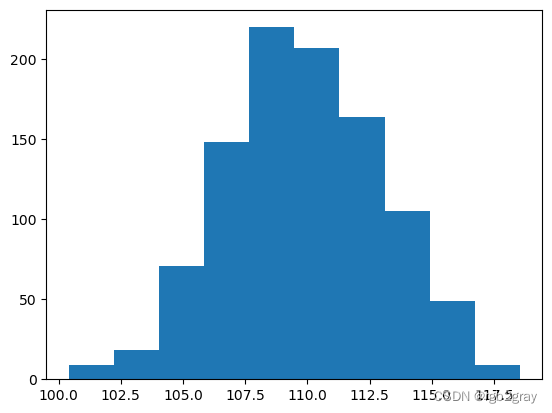
**重要提示:**这不是智商水平的分布! 这是给定样本(样本中有 10 名学生)的平均 IQ 水平超过 1,000 次的分布。
该分布的平均值为:
np.mean(sample_10_mean_list)
109.81834080140132
让我们与总体平均值进行比较:
np.mean(data)
110.07413289511938
相当接近!
如果我们1)增加样本量(10->100),样本均值是否会更接近真实均值? 2) 进行更多采样(10,000 -> 1,000,000)。 是的!
#Create an empty list to hold the numbers from each sample
sample_100_mean_list = []
for i in range(1000000):
#generate a sample with 100 numbers
sample = np.random.choice(data, 100)
#compute sample mean
sample_mean = np.mean(sample)
#print(i," sample mean: ", sample_mean)
#append them to the list
sample_100_mean_list.append(sample_mean)
plt.hist(sample_100_mean_list)
(array([6.80000e+01, 2.14900e+03, 2.68310e+04, 1.42865e+05, 3.29388e+05,
3.28362e+05, 1.41841e+05, 2.63350e+04, 2.09200e+03, 6.90000e+01]),
array([105.35779164, 106.30191012, 107.24602861, 108.1901471 ,
109.13426558, 110.07838407, 111.02250256, 111.96662104,
112.91073953, 113.85485802, 114.7989765 ]),
<BarContainer object of 10 artists>)
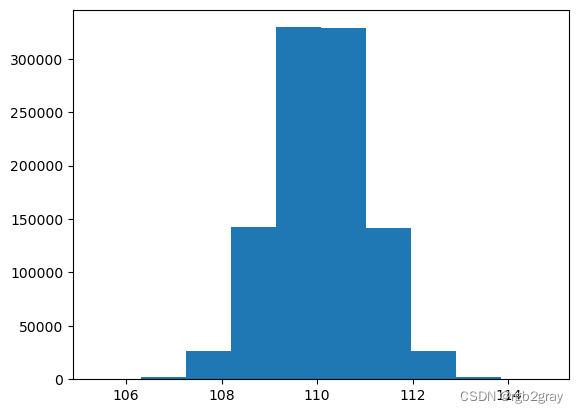
print("Average sample mean:", np.mean(sample_100_mean_list))
print("True mean:", np.mean(data))
Average sample mean: 110.07524696756842
True mean: 110.07413289511938
进一步增加样本量和样本次数将使样本均值收敛于真实总体均值,这表明样本均值是一个无偏统计量。
我们可以比较使用两个不同样本量时样本均值的分布。
plt.hist(sample_10_mean_list, density=True, alpha=0.5,bins=10,label='sample size = 10')
plt.hist(sample_100_mean_list, density=True, alpha=0.5,bins=10,label='sample size = 100')
plt.legend()
<matplotlib.legend.Legend at 0x1a70b3b9a90>
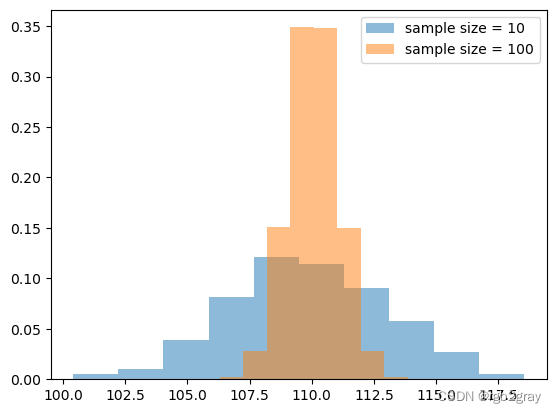
当样本量较小时,抽样分布更宽(即抽样变异性更大)!
这是因为:从分析上来说,样本均值的抽样分布遵循正态分布,均值为总体均值,标准差为: σ n \frac{\sigma}{\sqrt{n}} nσ
其中 σ \sigma σ 是总体标准差, n n n 是样本量。
print("Analytical SD of the sampling distribution:",
np.std(data)/np.sqrt(10))
print("Empirical SD of the sampling distribution:",
np.std(sample_10_mean_list))
Analytical SD of the sampling distribution: 3.1447294470942797
Empirical SD of the sampling distribution: 3.1421107844908382
print("Analytical SD of the sampling distribution:",
np.std(data)/np.sqrt(100))
print("Empirical SD of the sampling distribution:",
np.std(sample_100_mean_list))
Analytical SD of the sampling distribution: 0.9944507677819902
Empirical SD of the sampling distribution: 0.994316399287971
同样,让我们检查样本方差的抽样分布。
#define a small function to calculate sample variance.
def sample_var(sample):
mean = np.mean(sample)
n = sample.shape[0]
return np.sum((sample - mean)**2)/(n-1)
#One sample with 10 numbers
sample_10 = np.random.choice(data, 10)
sample_10
array([121.64683719, 103.11098717, 116.80834819, 103.55885849,
91.93607486, 110.61085577, 120.87592219, 101.59268352,
117.57011851, 108.56843983])
print("Sample variance is:", sample_var(sample_10))
Sample variance is: 93.84088686288874
#generate samples for multiple times
sample_10_variance_list = []
for i in range(10000):
#generate a sample with 10 numbers
sample = np.random.choice(data, 10)
#compute sample variance
sample_variance = sample_var(sample)
print(i," sample variance: ", sample_variance)
#append them to the list
sample_10_variance_list.append(sample_variance)
0 sample variance: 133.16255153634953
1 sample variance: 84.95111363055562
2 sample variance: 129.25853520691152
3 sample variance: 162.9507939120388
4 sample variance: 57.65250685184362
5 sample variance: 127.05245098320125
6 sample variance: 70.03273515311018
7 sample variance: 96.41498645686788
8 sample variance: 83.05696382116894
9 sample variance: 119.12242739103021
10 sample variance: 72.61720603700626
方差的抽样分布
plt.hist(sample_10_variance_list)
(array([9.170e+02, 3.058e+03, 3.017e+03, 1.754e+03, 8.010e+02, 2.870e+02,
1.000e+02, 5.400e+01, 9.000e+00, 3.000e+00]),
array([ 8.95012759, 45.1402609 , 81.3303942 , 117.5205275 ,
153.71066081, 189.90079411, 226.09092741, 262.28106072,
298.47119402, 334.66132733, 370.85146063]),
<BarContainer object of 10 artists>)
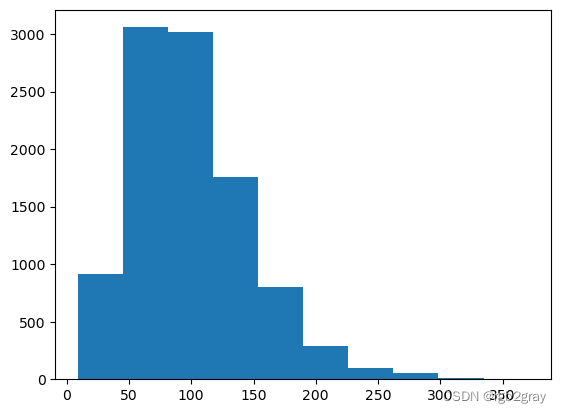
print("Average of sample variance:", np.mean(sample_10_variance_list))
print("True variance:", np.var(data))
Average of sample variance: 99.59784954844092
True variance: 98.89323295421896
再次,相当接近!
增加样本大小和样本数量:
#generate samples for multiple times
sample_100_variance_list = []
for i in range(1000000):
#generate a sample with 100 numbers
sample = np.random.choice(data, 100)
#compute sample variance
sample_variance = sample_var(sample)
#append them to the list
sample_100_variance_list.append(sample_variance)
print("Average of sample variance:", np.mean(sample_100_variance_list))
print("True variance:", np.var(data))
Average of sample variance: 98.88787841866694
True variance: 98.89323295421896
靠近点!
比较两个相同大小的样本均值的抽样分布。
plt.hist(sample_10_variance_list,density=True,alpha=0.5,bins=20,label='sample size = 10')
plt.hist(sample_100_variance_list,density=True,alpha=0.5,bins=20,label='sample size = 100')
plt.legend()
<matplotlib.legend.Legend at 0x1a701f14670>
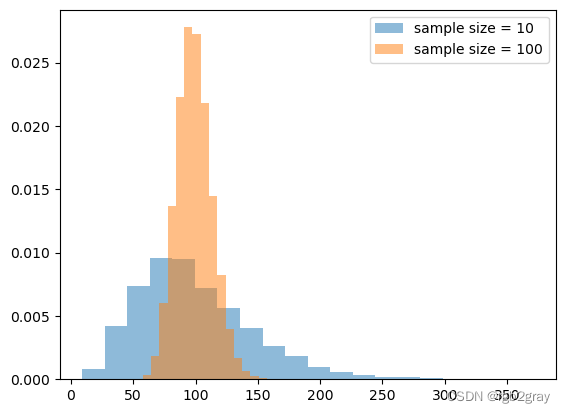
从分析上看,样本方差的抽样分布遵循自由度为 n - 1(n 为样本大小)的卡方分布。
( n − 1 ) s 2 / σ 2 ∼ χ n − 1 2 (n-1)s^2/\sigma^2 \sim \chi^2_{n-1} (n−1)s2/σ2∼χn−12
其中 s s s 是样本标准差, σ \sigma σ 是总体标准差
numpy 函数模拟卡方分布:random.chisquare(df, size=None)
anlytical_dist_10 = np.random.chisquare(10-1, 10000)*np.var(data)/(10-1)
anlytical_dist_100 = np.random.chisquare(100-1, 10000)*np.var(data)/(100-1)
plt.hist(anlytical_dist_10,density=True,alpha=0.5,bins=20,label='sample size = 10')
plt.hist(anlytical_dist_100,density=True,alpha=0.5,bins=20,label='sample size = 100')
plt.legend()
<matplotlib.legend.Legend at 0x1a711da2190>
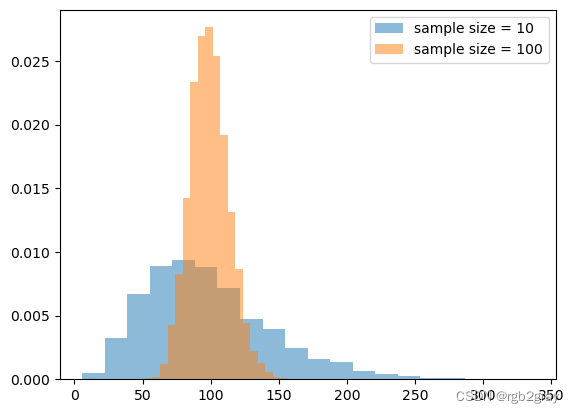
分析分布与我们的经验抽样分布相同!
